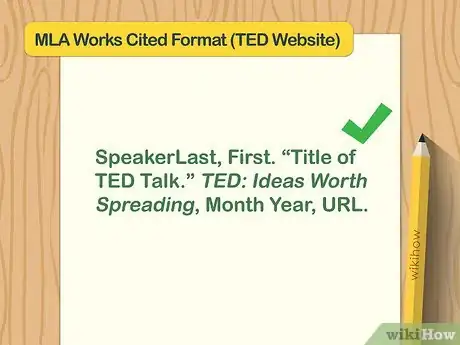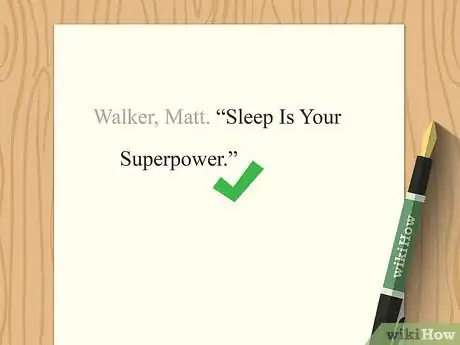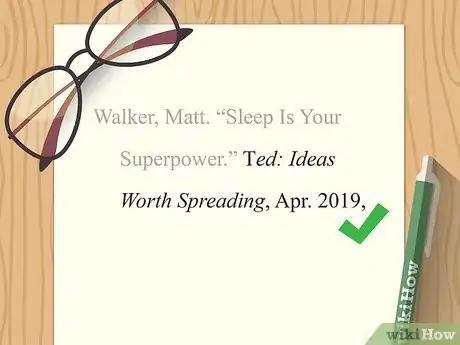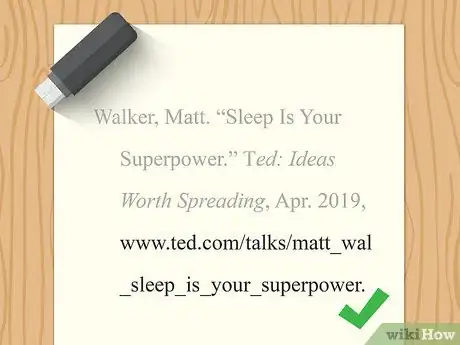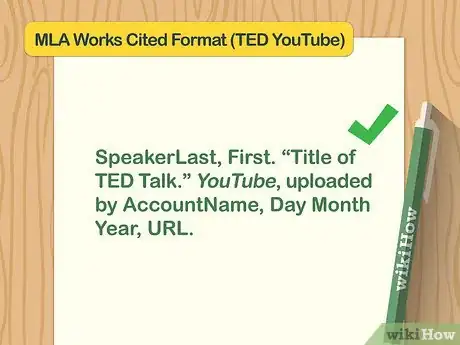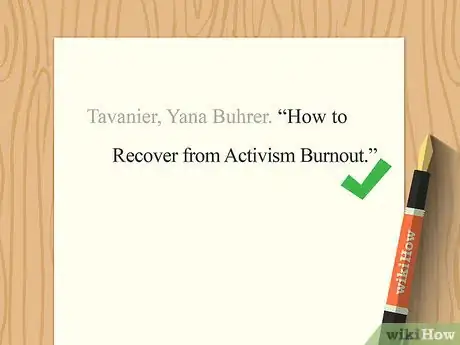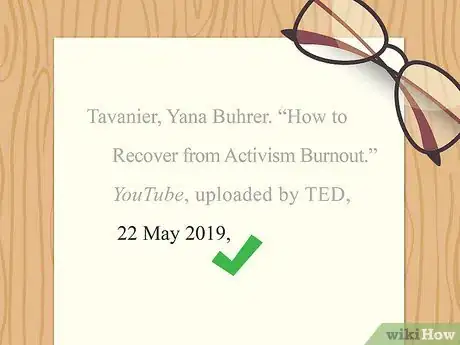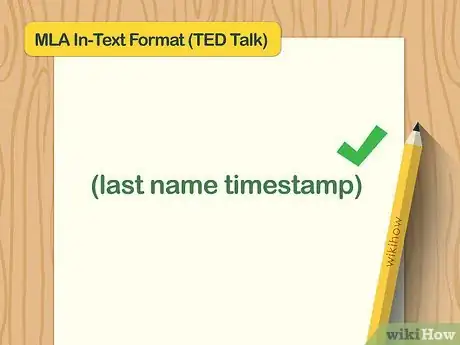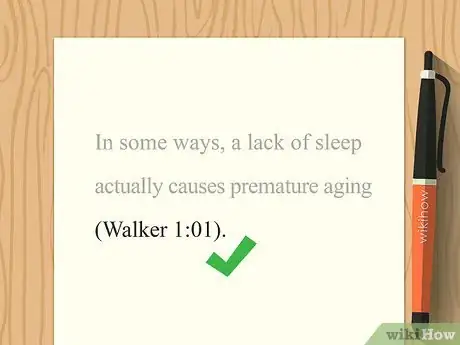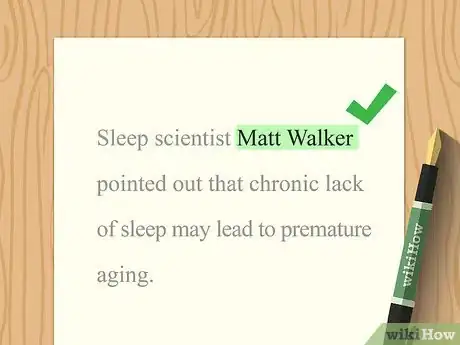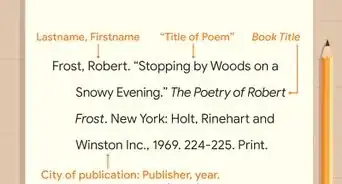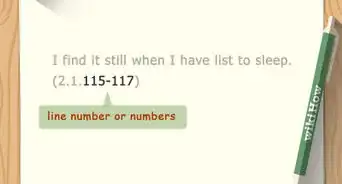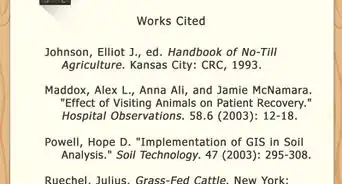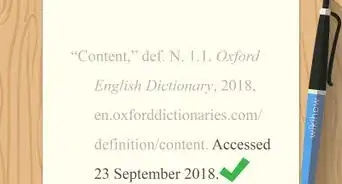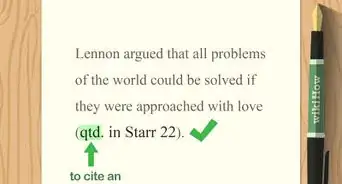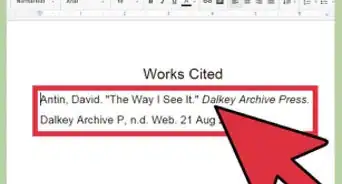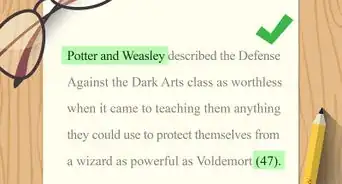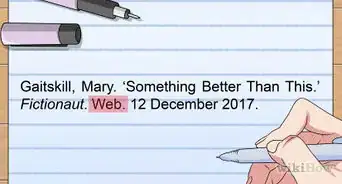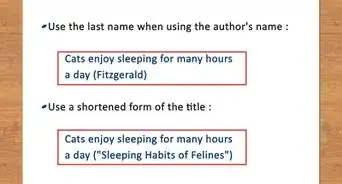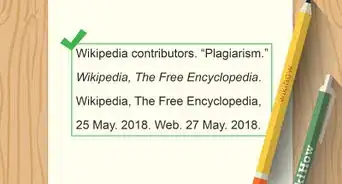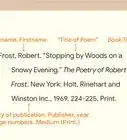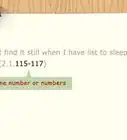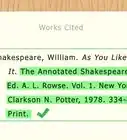This article was co-authored by wikiHow staff writer, Jennifer Mueller, JD. Jennifer Mueller is a wikiHow Content Creator. She specializes in reviewing, fact-checking, and evaluating wikiHow's content to ensure thoroughness and accuracy. Jennifer holds a JD from Indiana University Maurer School of Law in 2006.
This article has been viewed 46,399 times.
Learn more...
If you want to use ideas or information conveyed by a speaker in a TED Talk in your own research paper, you need to provide a citation to the original source. With Modern Language Association (MLA) style, proper citation includes a parenthetical citation in the text of your paper. That in-text citation points your readers to the full entry in your Works Cited at the end of your paper. For TED Talks, the format of your Works Cited entry differs depending on whether you accessed the TED Talk on the TED website or on YouTube.[1]
Steps
TED Website Works Cited Entry
-
1Start your entry with the name of the speaker. Type the last name of the speaker first, followed by a comma. Then type their first name. Include a middle name or initial if provided. Place a period after the speaker's name.[2]
- Example: Walker, Matt.
-
2Provide the title of the TED Talk in double quotation marks. After the name of the speaker, list the full title of the TED Talk. Do not include the speaker's name in the title. Use title case, capitalizing the first word and all nouns, pronouns, adjectives, adverbs, and verbs in the title. Place a period at the end, inside the closing quotation marks.[3]
- Example: Walker, Matt. "Sleep Is Your Superpower."
Advertisement -
3List the name of the website and date posted. The full name of the TED website is "TED: Ideas Worth Spreading." Italicize that name, followed by a comma. Then type the month and year that the video was posted. Abbreviate the names of months with more than 4 letters. Place a comma after the date.[4]
- Example: Walker, Matt. "Sleep Is Your Superpower." TED: Ideas Worth Spreading, Apr. 2019,
-
4Close your entry with the URL for the TED Talk. Following the date, copy and paste the URL for the TED Talk. In MLA style, remove the "http://" part of the URL. Place a period at the end of the URL.[5]
- Example: Walker, Matt. "Sleep Is Your Superpower." Ted: Ideas Worth Spreading, Apr. 2019, www.ted.com/talks/matt_walker_sleep_is_your_superpower.
Works Cited Format – TED Talk on TED Website
SpeakerLast, First. "Title of TED Talk." TED: Ideas Worth Spreading, Month Year, URL.
YouTube Works Cited Entry
-
1Use the name of the speaker as your first element. Type the speaker's last name, followed by a comma. Then add the speaker's first name. Include the speaker's middle name or initial, if provided. Place a period at the end of the speaker's name.[6]
- Example: Tavanier, Yana Buhrer.
-
2List the title of the TED Talk in double quotation marks. Following the name of the speaker, type the title of the TED Talk in title case. Capitalize the first word as well as all nouns, pronouns, adjectives, adverbs, and verbs in the title. Place a period at the end, inside the closing quotation marks.[7]
- Example: Tavanier, Yana Buhrer. "How to Recover from Activism Burnout."
-
3Include the name of the website and account. Type "YouTube" as the name of the website in italics, followed by a comma. Add the words "uploaded by" and list the name of the account where you found the video. Keep in mind there are several different TED channels on YouTube. Place a comma after the name of the account.[8]
- Example: Tavanier, Yana Buhrer. "How to Recover from Activism Burnout." YouTube, uploaded by TED,
Tip: Only use TED Talk videos from official TED channels as references. A TED Talk uploaded by another user may have been edited or altered.
-
4Add the date the video was posted. After the account name, type the date the video was uploaded to YouTube in day-month-year format. Abbreviate the names of months with 4 or more letters. Place a comma after the year.[9]
- Example: Tavanier, Yana Buhrer. "How to Recover from Activism Burnout." YouTube, uploaded by TED, 22 May 2019,
-
5Provide the URL to close out your entry.After the date, copy and paste the direct URL for the YouTube video. Do not include the "http://" part of the URL. Place a period at the end.[10]
- Example: Tavanier, Yana Buhrer. "How to Recover from Activism Burnout." YouTube, uploaded by TED, 22 May 2019, www.youtube.com/watch?v=LC5n91vKDZg.
Works Cited Format – TED Talk on YouTube
SpeakerLast, First. "Title of TED Talk." YouTube, uploaded by AccountName, Day Month Year, URL.
In-Text Citation
-
1Place a parenthetical citation after every in-text mention. MLA style calls for parenthetical citations at the end of every sentence in which you paraphrase or directly quote from a research source. The parenthetical citation directs your readers to the full citation in your Works Cited page.[11]
- Use the first element of your Works Cited entry in your parenthetical so your readers can find the right entry. In this case, your first element will be the last name of the speaker.
-
2Use a video timestamp to indicate the moment you referenced. MLA style typically requires you to provide a page number in your parenthetical citation where the material you quoted or paraphrased appears. However, since you're referencing a video, use a timestamp to direct your readers to the exact moment where that content appears. As you play the video, hover your cursor over the play bar to see the timestamp for a particular moment.[12]
- For example, you might write "In some ways, a lack of sleep actually causes premature aging (Walker 1:01)."
Tip: If you're quoting from the speaker directly, it may be helpful to your readers if you provide a range using a timestamp for the beginning of the quote and another for the end.
-
3Incorporate the name of the speaker in the body of your paper. If you use the speaker's name in your text, there's no need to repeat it in a parenthetical citation. Incorporating citation information this way can enhance the readability of your paper. You'll still need a parenthetical citation with the timestamp.[13]
- For example, you might write "Sleep scientist Matt Walker pointed out that chronic lack of sleep may lead to premature aging."
Warnings
- Factual information provided in TED Talks often isn't subject to the same rigorous review that the same information in a written source would be. Generally, your paper will be stronger if you find a more reliable written source.⧼thumbs_response⧽
References
- ↑ https://style.mla.org/citing-an-online-lecture-speech/
- ↑ https://style.mla.org/citing-an-online-lecture-speech/
- ↑ https://style.mla.org/citing-an-online-lecture-speech/
- ↑ https://style.mla.org/citing-an-online-lecture-speech/
- ↑ https://style.mla.org/citing-an-online-lecture-speech/
- ↑ https://otis.libguides.com/mla_citations/videos
- ↑ https://otis.libguides.com/mla_citations/videos
- ↑ https://otis.libguides.com/mla_citations/videos
- ↑ https://otis.libguides.com/mla_citations/videos
